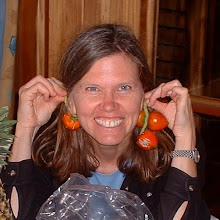One day at our weekly Scrabble get together in Monteverde, a player browsing through the dictionary read out, "Qiviet, the wool of a musk ox" and said "Who on earth would know THAT word?" Happily, I am among the lucky few with qiviet experience. Qiviet is a gloriously soft and quite rare fiber. The arctic muskox sheds its thick undercoat all in a very short period in spring and it is combed, not sheared from the coarser guard hairs. Native people used to collect tufts of qiviet that had caught on plants. That was probably easier than cornering a wild animal that as an adult weighs an average of 285 kg/630 pounds. In fact, some qiviet is still collected in the traditional way.
Friends that visited the
Large Animal Research Station in Fairbanks gave me an ounce of a blend of 70% qiviet and 30% merino wool. The merino adds some spring that qiviet doesn't have, so it's an excellent blend for knitting. Qiviet itself is softer than cashmere and eight times warmer than sheep's wool.
One ounce of my yarn was only 135 yards; we are talking a seriously rare and expensive fiber. After much thought I decided to knit a lace cowl because of the wonderful softness and because that way I won't lose it. I used a pattern called
Abstract Leaves Cowl by Deb Mulder. It's available free on Ravelry.
Knit up, the yarn is much softer than in the skein. That's saying a lot because the skein is pretty darn soft. A sort of haze or halo develops around the yarn and according to the Large Animal Research Station website, the halo will continue to develop. On their web site you can see a fascinating video of an animal being combed. The fleece comes off in a big sheet or fleece. They also have yarn you can invest in.
I love looking at the cowl close up. The color was called Blueberry but basically it's muskox color with undertones of bluish purple. I usually block lace but I'm going to wear this scrunched up on my neck so I didn't bother.
While knitting this cowl I made use of my handy little electronic scale. For example I weighed my ball of yarn before and after a row of knitting and determined that one row took .5 grams of yarn. Thus I could calculate how many rows of the pattern I could do. I could also calculate when to change to the garter stitch border so that I would have enough to finish. It worked out very well because I had less than a yard left when I cast off. (I even have a project in mind for that little bit: it should be enough to make one or two knit acorns.)
This cowl is probably the warmest garment you can make with an ounce of yarn. With the unusually cold weather we are having this week it's reassuring to have this luscious garment available.





























